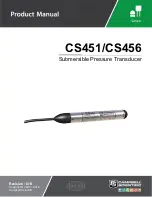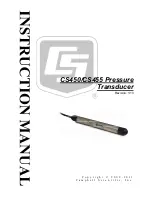
D2133_01_04 CN5082 SEM110 User Guide
1.0 GENERAL
The SEM110 series are high performance two wire (4 to 20) mA
transmitters designed to accept most standard industrial temperature,
thermocouple, slide wire and variable resistance sensors which operate
over most common ranges. Automatic thermocouple cold junction
compensation is provided on thermocouple versions where the output is
directly referenced to the mV input, allowing linearisation to be carried out
by the loop monitoring instrumentation, if required. The device is potted
inside a plastic enclosure, suitable for head mounting into any DIN style
enclosure. Screw terminals are provided for wire connections. Trim
potentiometers are provided to allow calibration adjustments.
2.0 SEM110 SPECIFICATION @ 20 ºC
Part Number
Input Type
SEM110TC
Isolated (Un-grounded) Thermocouple types
K,T,J,R,S,N
SEM110P
PT100, PT10, PT1000
SEM110W
Slide Wire
SEM110Z
Variable resistance
SEM110D
Differential PT100
OUTPUT
(4 to 20) mA two wire (Max 30 mA)
SUPPLY VOLTAGE
(10 to 45) V DC reverse connection protected.
30 VDC Max
I.S. version
AMBIENT TEMP
(0 to 70) ºC operation
(-40 to 100) ºC storage
AMBIENT HUMIDITY
(0 to 95) % (non condensing)
CONNECTION
Screw Terminal
Recommended cable size 2.5 mm sq.
ZERO DRIFT
±2 µA/ºC
SPAN DRIFT
±0.01 %/ºC
LOOP RESISTANCE 700 R Max (24 V)
EMC
Conforms to BS EN 61326
3.0 INSTALLATION
3.1 Mechanical
The transmitter is mounted using two 4.5 mm diameter holes, on standard
33 mm fixing centres. This transmitter has been specifically designed to
be mounted inside a DIN standard probe head, which must provide
adequate protection to moisture, corrosive atmospheres etc. All cable
entries should be sealed using the correct size cable gland.
Care must be taken when locating the transmitter to ensure the ambient
temperature remains inside the specified range of (0 to 70) ºC. The
diagram shows the mechanical layout with a typical application of the
transmitter mounted inside a probe head enclosure.
Mounting Holes: 2 Holes 4.5 mm Diameter, 33 mm Centres
3.2 Electrical
Connections to the transmitter are made to the screw terminals provided
on the top face.
The SEM110 conforms to BS EN 61326 and as such, the radiated
electromagnetic susceptibility is tested to 3 v/m. It is therefore recommend
that during the installation process, the instrument should be mounted
away from any high powered radio transmitters and away from any heavy
switching gear.
To maintain EMC compliance input/sensor wires must be less than 3
metres long and output wiring must use screened twisted pair cable with
the screen earthed at one end only.
All three input wires must have the same core diameter to maintain equal
lead resistance in each wire. T/C sensors must be ungrounded.
The transmitter is protected against reverse connection by means of a
series diode, therefore incorrect connection of the output wires will result in
near zero current flow in the loop. Incorrect connection or failure of the
sensor wires will result in the transmitter saturating, T/C versions go
upscale, whilst resistance sensor inputs go either upscale or downscale
dependant upon which wire breaks. The most common failure would be a
total sensor burnout, in which case the
transmitter will go upscale.
3.3 connections
Pt 100, 3 Wire
Only TC with Isolated Junction
Type D, Differential Temperature
Type W, Slide wire
Type Z, Variable Resistor
The diagram shows the method of connection to provide a (4 to 20) mA
current loop output.
SEM110
TEMPERATURE TRANSMITTER
Designed, manufactured and supported by:
Status Business Park, Gannaway Lane
Tewkesbury Glos. G
L
20 8FD. UK
Tel: +44 (0)1684 296818 Fax: +44 (0)1684 293746
Email:
Every effort has been taken to ensure the accuracy of this specification, however we do
not accept responsibility for damage, injury, loss or expense resulting from errors and
omissions, and we reserve the right of amendment without notice
LOAD
POWER
(24V NOM)
SUPPLY
-
+
Ra-Rb
Rb
Ra
20mA
4mA
3 2 .0
1 .8
5 3 .0
Z e ro
S p a n




















